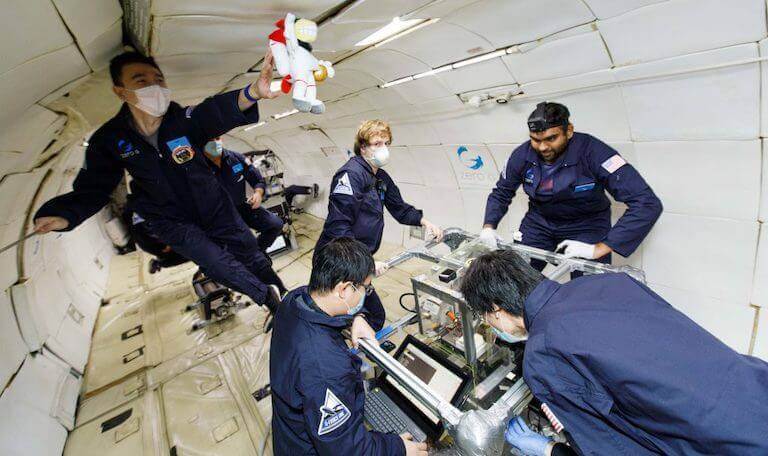Cyclone engineers take to the sky for advanced manufacturing research
Posted Feb 1, 2022

Posted Feb 1, 2022

A team of Iowa State University College of Engineering researchers recently experienced something that few ever will: a zero-gravity environment.
The research team, led by Hantang Qin, assistant professor in industrial and manufacturing systems engineering (IMSE), and Shan Jiang, assistant professor in materials science and engineering (MSE), set out to test the novel 3D printing process they developed in a zero-gravity environment. They developed this process in recent years inside Qin’s Flexible Electronics and Additive Printing Laboratory on the Iowa State University campus leading up to the zero-gravity test flight, which took place at the Fort Lauderdale International Airport, Zero Gravity Corporation’s (Zero-G) research operations base, in Fort Lauderdale, Fla. last month. The team has dubbed their effort NINJAS – No-Gravity INk Jet Printing for Aeronautics and Space.
“The main goal of our experiment was to print a conductive circuit pattern in microgravity,” said Qin. “We tested multiple types of ink with different material properties, such as density, surface tension and permittivity, while pinpointing the optimal operating conditions, including voltage, pulse frequency and nozzle orientation.”

With the help of NASA’s Flight Opportunities program, the team has developed brand new ways to synthesize silver and barium titanate inks (patent pending) and successfully print those inks to a glass substrate during the test flight. These particular inks are desirable for their applications in printing electronic devices, including general circuitry, capacitors and humidity sensors, according to Qin and Jiang. The team hopes that the findings from this research might improve the manufacturing of flexible sensors, soft robotics, circuit boards, semiconductors and other micro-scale electronic devices on earth as well as in space.
Qin is the project’s Principal Investigator (PI) and he is supported by Co-PIs Shan Jiang; Juan Ren, associate professor in mechanical engineering; and Pavithra Premaratne, an Iowa State University aerospace engineering alumnus who currently serves as an assistant professor of physics and engineering at Central College in Pella, Iowa. The mechanical and industrial engineering team handled the development of the in-space printer, while the materials engineering team developed the inks used for testing.
“My students helped in the design and assembly of the new inkjet printer, hardware-wise,” said Ren. “Also, we designed the software of the printer, including signal routing, stage motion control and user interface.”
Qin said vibrations from the aircraft transferring to the 3D printer onboard was one of the biggest challenges the team faced. Vibrations from the aircraft engine coupled with the turbulence caused disruptions to the nozzle of the 3D printer while in operation. The team attempted to recreate these vibrations in the months leading up to the test flight by operating the printer while driving a car around Ames. Qin said the team was able overcome the obstacles that the vibrations presented during the test flight by adjusting factors such as the voltage of the electric field and distance from the printer nozzle to the glass substrate. Adjusting the pulse frequency also alleviated some of the vibration-induced issues.
Adapting to the physical sensation of a zero-gravity environment was another challenge the researchers faced. Qin said motion sickness medicine helped them to deal with the nausea caused by the zero-gravity environment and he compared the sensation to “operating a printer while literally jumping off a 30,000-foot building.” Matthew Marander, a Ph.D. student in MSE, said the sensation was like being in a pool, but with less to push against.
“The zero-gravity environment wasn’t even that difficult to adjust to the feeling of,” said Marander. “What I felt was more difficult to deal with was the feeling of rapid transition between hyper-gravity, the normal gravity and zero-gravity. Switching between all of them so quickly can feel a little bit disorienting.”
Qin said he was grateful to have a diverse, interdisciplinary team of researchers for the project, which he feels has helped to contribute to its success so far.
“Diversity triggers innovation and competitiveness, which benefits all individuals involved in the learning process,” said Qin. “Learning with people from a variety of backgrounds elevates collaboration, encourages hard work and builds an energetic setting for new ideas.”

This work builds upon past research Jiang and his Soft Matter and Nano Engineering Lab have conducted in the area of nanoparticle synthesis and material formulation, and it also advances past work Jiang and Qin have done through the NASA Iowa Space Grant Consortium and the Iowa NASA EPSCoR Research Building Seed Grant program. Qin and the team are grateful for the support they received from Tomas Gonzalez-Torres and Kelsey Mueller with Iowa NASA EPSCoR as well as from Zero Gravity Corporation, NASA’s Space Technology Mission Directorate Flight Opportunities program and the NASA Marshall Space Flight Center.
The team plans to further improve their 3D printing technique and is in the process of applying for another parabolic flight test in May 2022.
“We want to help NASA develop a platform that can greatly expand the materials and devices they can make in space,” Jiang said.
Additionally, they hope to develop a nozzle head to be used for NASA’s International Space Station printer before 2024.
“In the future, we aim to improve the structural integrity of the setup and test different ink combinations to improve the print quality and functionality,” Qin said.